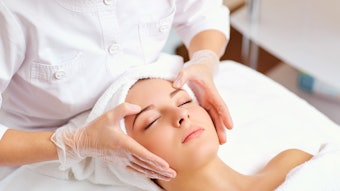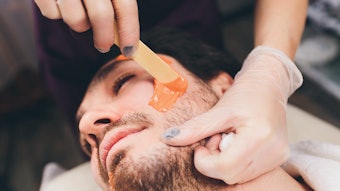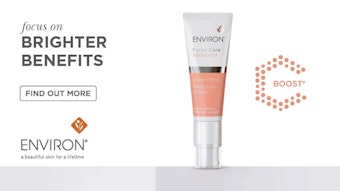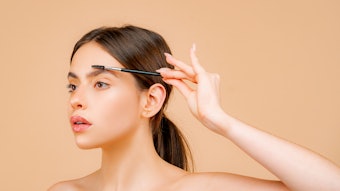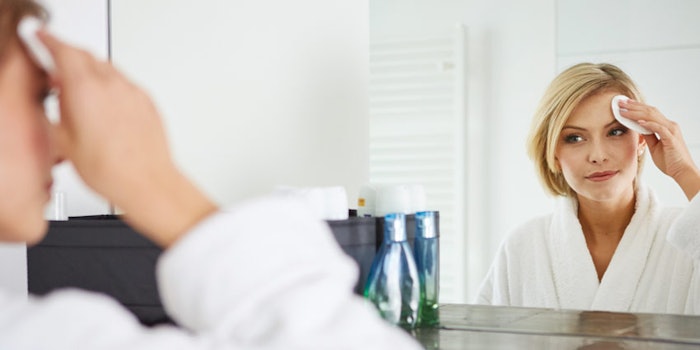
Millions of Americans suffer from sensitive skin, rosacea or both. At first glance, both of these conditions display some similarities, making it easy to misdiagnose. On top of that, there are numerous misconceptions surrounding these two skin conditions.
Being able to differentiate between skin sensitivities and other issues such as rosacea, is core to being able to design an effective course of action in the treatment room and safely restore a client’s skin to optimum health. How do you differentiate between these similar issues? It begins with some simple questions and understanding of lifestyle to get a full picture.
What is Sensitive Skin?
Skin is a reactive mechanism that responds to various elements and disturbances inside and out. To a certain extent, all skin can have some degree of sensitivity, but it is the level of reaction that signifies whether skin is truly sensitive.
While millions think they have “sensitive skin,” it is actually commonly misunderstood and overused as it relates to skin type. Many of those with sensitive skin are just responding to what we refer to as “skin irritants,” which are an overabundance of parabens, synthetic fragrances and dyes. Many times, the sensitivities change once these types of ingredients are removed from the client’s regimen.
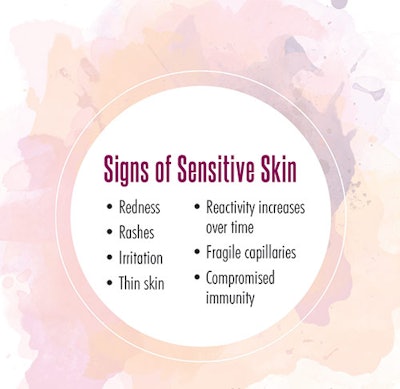
Truly sensitive skin can be sensitive to touch, redden easily and experience rashes or other irritations frequently. Some of those with sensitive skin have compromised immunity and health issues at the cellular level, while others could be sensitive due to a medical procedure that went too far. Other causes would be extreme outside elements such as sun, wind and heavy pollution. Smoking or excessive drinking can cause the skin to become sensitive as well. Sensitive skin also tends to be thinner and more prone to fragile capillaries than average skin.
Rosacea
Rosacea is a chronic and progressive disorder that impacts 16 million Americans.1 Rosacea will typically present as redness on the cheeks, nose, chin or forehead that will come and go. It is a complex condition, with three stages of progressed symptoms.
Stage 1. The first stage will often manifest as frequent blushing or flushing when skin becomes irritated by certain topicals, acne medications, chemical-based sunscreens and improper care and protection.
Stage 2. The second stage will appear as a continuous reddening of the skin. Expanded surfaced capillaries and papules or pustules may also appear.
Stage 3. The third stage is a deeper, more persistent redness often accompanied by dilated veins particularly around the nose. An early sign is fibroplasia (excess tissue growth), which may produce enlarged pores.
There are many theories around what causes rosacea; however, much of the research points to internal issues. There are four causes that are typically seen underlying most cases of rosacea. These include:
- Bad bacteria is not able to release itself from the body, resulting in gut issues;
- The circulatory system is sluggish,
- The nervous system is impacted through emotional stress, and
- The demodex mites are substantially higher with rosacea skin.2
It’s important to note, rosacea does not develop as a result of poor hygiene. It is a systemic issue and will often require a deeper root issue being addressed, in addition to treatments designed to bring the skin back to optimal health.
Common triggers that aggravate rosacea include: spicy foods, alcohol, extreme temperatures, certain cosmetics, drugs or medications that dilate blood vessels, stress and sunlight. Educate clients about these common triggers, as it will be important to eliminate as many as possible from their lifestyle.

The promising aspect with rosacea is we can make an impact and slow down the progression from stage one to three. This is why early diagnosis is so important. It will prevent the disorder from developing to stage three and make it easier to manage. Plus, it is often easier to treat and restore skin back to optimal health when detected early.
While rosacea and sensitive skin are impacted by similar elements, each is different and will require a different course of action. A skin assessment, including a skin history, patch testing and observing the skin over time is essential to truly understand what is going on beneath the surface.
Restoring Compromised Skin
There is not a one-size-fits-all remedy to these issues, as each will require a personalized approach to fit the exact needs of the skin. There are a few best practices for restoring the health and vitality of these compromised skin conditions. Both sensitive and rosacea skins respond better to beta hydroxy acids versus alpha hydroxy acids.
Treatment: Sensitive Skin
This skin can be strengthened over time and restored to a “normal” state. To do so, incorporate ingredients like: retinaldehyde; mandelic acid; stem cells; growth factors; anti-inflammatories; flower extracts like chamomile, edelweiss, purple coneflower and cornflower; as well as vitamins.
Hibiscus acid is amazing in the treatment room, as it can bring rejuvenation without further irritating the skin. A series of progressive vitamin A treatments is a strong recommendation to strengthen skin integrity and desensitize the skin, bringing it to a less reactive state. This will also regenerate and stimulate new, healthy cells to surface for overall skin well-being.
Treatment: Rosacea
Rosacea skin ingredients need to be more focused on reducing redness, bacteria, inflammation and strengthening the skin from within. Ingredients like retinaldehyde, mandelic acid, arginine, salicylic acid, stem cells, sea buckthorn oil, omega essential fatty acids and the flower extracts mentioned above can achieve this.
These are merely a few ingredients that will address rosacea by reducing inflammation, providing antimicrobial benefits, soothing, nourishing, providing wound-healing support and strengthening blood vessels and the capillary wall.

In the treatment room, the approach will change depending on the stage of rosacea. A series of chemical peels ranging from progressive to mid depth can make an improvement and help home-care products to work more efficiently. Avoid extreme heat and cold, applying these with moderation. Chilled ice globes gently rolled over gauze covering the skin during the treatment reduces inflammation and redness. Always finish with a mineral-based protection formula.
The goal for rosacea clients in the treatment room is to strengthen the skin without over-stimulating the underlying inflammation. This is achieved primarily through the use of “rosacea friendly” ingredients, specific facials and peels and techniques that increase overall circulation like moderate microdermabrasion, O2 applications, massage and stimulating the lymphatic system.
Similar to treatments for sensitive skin, hibiscus acid, BHAs and retinols typically work best for rosacea. Stimulating lymphatic flow is also a highly beneficial treatment for those challenged by rosacea or inflammation. This is a precise skin movement technique that occurs at the surface level of the skin. The technique doesn’t involve moving any of the tissue underneath the skin, but rather stimulates the lymph to move more efficiently. The fluid in the lymphatic system comprised of white blood cells attack bacteria in the blood. When the lymph is clogged, it becomes more difficult for the body to purify and cleanse itself resulting in the effects that are visible on the skin.
Designing a Home Care Solution
Whether skin is sensitive or challenged by rosacea, it’s important to educate clients about the role of proper home care and how lifestyle choices will impact their skin health. When it comes to rosacea, there are two primary contributing factors that clients must address besides daily care topicals: stress and inflammation.
When the body is under constant stress, the immune system weakens. Sleep, exercise, taking time to rejuvenate, breathing consciously, eating life-giving foods and treating the skin with healthy, intelligent ingredients will help support a healthy immune system and keep inflammation at bay. Protecting the skin from free radicals can help prevent an increase in inflammation, which causes more redness and sensitivities. Clients should also be cognizant to cleanse nightly before bed and never go to sleep wearing makeup.
Sensitive skin can be impacted by lifestyle factors as well, so it is important to talk to clients about creating healthy lifestyle habits.
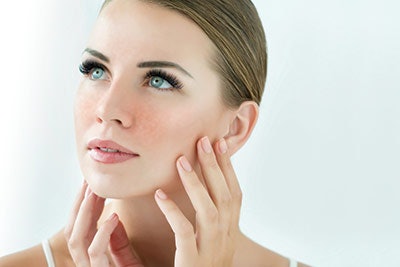
Overall formulation can be the difference maker, not just the ingredient itself. Think about integrating chirally correct ingredients to boost the properties and increase effectiveness. Also, don’t forget about leaving those skin irritants off the skin.
For all skin types and conditions, daily sun protection is a must; however, it is particularly essential for skin that is compromised like sensitive skin and skin with rosacea. Selecting a natural physical block such as zinc oxide will offer protection while delivering mineral and antioxidant benefits to the skin.
Keep in mind, while the goal of these challenges is to stimulate cell turnover and strengthen the skin, it’s equally paramount to eliminate triggers and aggressors. Add in the good elements such as antioxidants, anti-inflammatories, vitamins and minerals, and eliminate the offenders such as fragrances, dyes, certain preservatives and overexposure to damaging elements.
Know the Signs
Before diagnosing, be sure you know the signs of each of these issues. Proper diagnosis is absolutely key. Then, share your knowledge with your clients. If they know the triggers to avoid and how to properly care for their skin to support the work you’re doing in the treatment room, you’ll be better equipped to reach your shared goal of restoring the skin to optimum health.
REFERENCES




